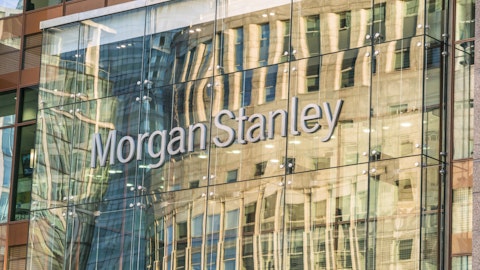Truist Financial Corporation (NYSE:TFC) Q4 2023 Earnings Call Transcript January 18, 2024
Truist Financial Corporation beats earnings expectations. Reported EPS is $0.91, expectations were $0.88. Truist Financial Corporation isn’t one of the 30 most popular stocks among hedge funds at the end of the third quarter (see the details here).
Operator: Greetings, ladies and gentlemen, and welcome to the Truist Financial Corporation Fourth Quarter 2023 Earnings Conference Call. Currently, all participants are in listen-only mode. A brief question-and-answer session will follow the formal presentation. As a reminder, this event is being recorded. It is now my pleasure to introduce your host Mr. Brad Milsaps.
Brad Milsaps: Thank you, Rocco, and good morning, everyone. Welcome to Truist’s fourth quarter 2023 earnings call. With us today are our Chairman and CEO Bill Rogers and our CFO Mike Maguire. During this morning’s call, they will discuss Truist’s fourth quarter results, share their perspectives on current business conditions, and provide an updated outlook for 2024. Clarke Starnes, our Vice Chair and Chief Risk Officer; Beau Cummins, our Vice Chair and Chief Operating Officer; Donta Wilson, Chief Consumer and Small Business Banking Officer; and John Howard, Truist Insurance Holdings Chairman and CEO are also in attendance and available to participate in the Q&A portion of our call. The accompanying presentation, as well as our earnings release and supplemental financial information, are available on the Truist Investor Relations website ir.truist.com.
Our presentation today will include forward-looking statements and certain non-GAAP financial measures. Please review these disclosures on slides two and three of the presentation regarding these statements and measures, as well as the appendix for appropriate reconciliations to GAAP. With that, I’ll turn it over to Bill.
Bill Rogers: Thanks, Brad and good morning, everybody, and thank you for joining our call today. Before we discuss our fourth quarter results, let’s begin with our purpose on slide four. As you know, Truist is a purpose-driven company committed to inspiring and building better lives in communities. I’d like to take just a few moments to highlight some of the ways we demonstrated our purpose during 2023. Through Truist Community Capital, we committed nearly $2.1 billion to support more than 15,000 units of affordable housing. This helped create more than 15,000 jobs and serve more than 130,000 people in low and modern income communities this year. Also, our teammates impacted 5,300 organizations and causes through their charitable giving and more than 62,000 hours of volunteer service.
In addition, we started a small business community heroes initiative, which empowers our branch teammates alongside our virtual small business specialist leveraging our digital solutions to proactively connect via caring conversations with small business owners, who tirelessly work to serve our neighbors, create jobs, build our communities, and help drive our economy. So those are just a few examples of the meaningful work we’re doing as a company to have a positive impact on the lives of our clients, our teammates, our communities, and our shareholders as we work to realize our purpose. All right, so let’s turn to some of the key takeaways on slide six. Truist reported solid fourth quarter results, adjusted earnings after excluding several discrete items that impacted our results.
The largest of these items, of course is a $6.1 billion goodwill impairment charge. Mike’s going to provide more details later in our call, but this is the result of our annual impairment test, which we conduct each year as of October 1. So importantly, this is — charge is non-cash, it has no impact on our liquidity, regulatory capital ratios, the payment of our common dividend, or our ability to do business and serve our clients. On an adjusted basis, we reported net income of $1.1 billion or $0.81 a share, which excludes the impact of the impairment charge, the industry-wide FDIC special assessment, and a discrete tax benefit. In addition, pre-tax merger related and restructuring charges of $183 million negatively impacted adjusted EPS by $0.10 per share.
Most of these charges were related to our cost saving plan. Despite these discrete items in the quarter, we’re pleased with our underlying results. As you can see on the slide, our solid performance was defined by several key themes. First, we made strong progress on our organization simplification plan during this quarter. Since these initiatives were announced in mid-September, we’ve reduced headcount, relined significant elements of our organizational structure to improve efficiency and to drive revenue opportunities in 2024 and beyond. As a result of these efforts and others through 2023, the fourth quarter marks the second consecutive quarter we’ve seen our expenses decline. Although the first quarter will experience typical seasonal expense headwinds, we’re on track and fully committed to delivering on the cost initiatives that we outlined in September, which will limit adjusted expense growth to flat to up to 1% in 2024, while also continuing to invest in initiatives for our core clients, technology, and risk management.
Although asset quality is normalizing off historically low levels, we’re encouraged that non-performing loans decline during the quarter, while we continue to build our loan loss reserve considering the uncertain economic environment. Consistent with our capital planning strategy, our CET1 ratio increased 20 basis points sequentially to 10.1. Although we’re committed to building capital, our balance sheet also remains open to core clients as our primary capital priorities are supporting the financial needs of new and existing clients and the payment of our common dividend. So before I hand the call over to Mike to discuss our financial performance in more detail, let me provide a quick update on our progress we’re making on improving the experiences for our clients, we’ll do that on slide seven.
Truist continues to see improved digital engagement trends with strong transaction growth over the last year. Mobile app users grew 9% versus the fourth quarter of 2022, which is contributing to increased transaction volumes, which now account for 62% of total bank transactions. As shown in the chart on the left, growth in digital transactions is primarily reflected by increased Zelle usage as clients continue to value efficient payment and money movement capabilities. While this is certainly positive, Truist still has a meaningful opportunity to shift the transaction mix even more towards digital, specifically by leveraging our T3 strategy, which is the concept that touch and technology work together to create trust. That further enhances the client experience and drives greater digital adoption and efficiency.
Our goal is to create seamless experiences for our clients by offering more self-service capabilities to enhance the overall client experience. Truist Assist is a perfect example of this concept. Since launching in 2022, we’ve seen increased client adoption with one-third of the total interactions represented in the fourth quarter of 2023 alone. Additionally, 85% of the conversations were completed using the automated assistant this quarter. As we look into 2024 we expect accelerated adoption of Truist Assist, which should lead to additional operational efficiencies for Truist. Overall, I’m pleased with the digital progress we’ve made in 2023 and excited about the opportunity to further leverage T3 in 2024 and beyond that. So let me turn it over to Mike to discuss our financial results in a little more detail.
Mike?
Mike Maguire: Great, thank you Bill and good morning everyone. For the quarter we reported a GAAP net loss of $5.2 billion or $3.85 per share. As Bill noted reported earnings per share were impacted by several items detailed at the top of slide eight. Those include a non-cash goodwill impairment charge of $6.1 billion, a special FDIC assessment of $507 million, and a discrete tax benefit of $204 million. Excluding these three items, adjusted net income was $1.1 billion or $0.81 per share. In addition, merger-related and restructuring charges, primarily related to severance and branch consolidation associated with our call-saves initiatives, negatively impacted EPS by another $0.10. Before providing further details on this quarter’s underlying financial performance, I do want to provide some additional background on the goodwill impairment charge that occurred during the quarter.
We test our goodwill for impairment annually on October 1. This year’s test resulted in an impairment of $6.1 billion. The impairment was primarily driven by the continued impact of higher interest rates and higher discount rates and a sustained decline in banking industry share prices, including Truist share price. Importantly, as Bill noted in his opening remarks, this is a non-cash charge and has no impact on our liquidity, no impact on our regulatory capital ratios, our ability to pay our common stock dividend or to serve the needs of our clients. Moving on to the results for the quarter. Total revenue increased 50 basis points sequentially due to a more modest decline in net interest income than expected. Adjusted expenses declined 4.5% or 5.2%, if excluding the impact of TIH Independence Readiness Costs.
Our net interest margin improved 3 basis points to 2.98% during the quarter. We added 20 basis points to CET1 capital in the quarter and increased our ALLL ratio by 5 basis points in light of ongoing economic uncertainty. Finally, our tangible book value per share increased 13% on a linked quarter basis, due primarily to the impact of lower interest rates on the value of our available for sale investment portfolio. Next, we’ll turn to page nine to cover loans and leases. Average loans decreased 1.7% sequentially, reflecting our ongoing balance sheet optimization efforts and overall weaker client demand. Average commercial loans decreased 1.8%, primarily due to a 2.3% decrease in CNI balances, primarily due to lower client demand. In our consumer portfolio, average loans decreased 1.8%, primarily due to further reductions in indirect auto and mortgage.
Overall, we expect average commercial and consumer balances decline modestly in the first quarter driven by our ongoing mix shift toward deeper client relationships, deemphasizing lower return portfolios, and the effects of continued economic uncertainty. Moving now to deposit trends on slide 10. Average deposits decreased 1.4% sequentially as growth in time deposits and interest checking was more than offset by declines in non-interest-bearing and money market balances. Non-interest-bearing deposits decreased 3.7% and represented 29% of total deposits, compared to 30% in the third quarter and 34% in the fourth quarter of 2022. During the quarter, consumers continued to seek higher rate alternatives, which drove an increase in deposit costs, albeit at a slower pace relative to recent periods.
Typically, total deposit costs increased 9 basis points sequentially to 1.90%, down from a 30 basis point increase in the prior quarter, which resulted in just a 100 basis point increase to our cumulative total deposit beta to 36%. Similarly, interest bearing deposit costs increased 10 basis points, sequentially to 2.67%, down from a 38 basis point increase in the prior quarter, which also resulted in a 100 basis point increase to our cumulative total interest bearing deposit beta to 50%. Going forward, we will continue to maintain a balanced approach, focusing on core relationships, staying attentive to client needs, and striving to maximize the value we can add to relationships outside of rate paid. Moving the net interest income and net interest margin on slide 11.
For the quarter, taxable equivalent net interest income decreased by 0.6% linked quarter due to lower average earning assets and higher rate paid on deposits partially offset by favorable hedge income. Reported net interest margin improved 3 basis points on a linked basis quarter. While net interest margin expanded in each of the last two quarters, we expected to contract in the first quarter due to an increase in rate paid on deposits partially offset by continued improvement and spreads on new and renewed loans. Turning the non-interest income on slide 12. Fee income increased $47 million or 2.2% relative to the third quarter. The linked quarter increase was primarily attributable to higher service charges on deposits, which were up $76 million in the fourth quarter, due primarily to the third quarter being impacted by $87 million of client refunds.
Lending-related fees increased $51 million linked quarter, due to higher leasing related gains. And other fees declined $66 million due to lower equity income. Fee income was down 3.2% on a like quarter basis as lower investment banking and trading, deposit service charges, mortgage banking and other income were partially offset with higher insurance income and higher lending related fees. Next I’ll cover non-interest expense on slide 13, GAAP expenses of $10.3 billion increased 6$.5 billion linked quarter due primarily to the previously mentioned $6.1 billion goodwill impairment charge, the $507 million FDIC special assessment, and a $108 million increase in merger-related restructuring expense, partially offset by a $183 million decline in personnel costs.

Excluding these items and the impact of intangible amortization, adjusted non-interest expense declined 4.5% sequentially or 5.2%, excluding the impact of $33 million of TIH independence readiness costs. The decrease in adjusted expense was driven by lower personnel expense due to the execution of our cost savings program, resulting in headcount reductions, as well as lower incentive compensation to reflect our performance in 2023. These improvements were partially offset with higher professional and outside processing expenses. Adjusted non-interest expenses were essentially flat on a light-quarter basis. As Bill mentioned, we are pleased with the progress that we’ve made on the cost savings initiative that we announced in September. Our original goal was to eliminate or avoid expenses of approximately $750 million over a 12 to 18 month period, which would help us manage our expense growth in 2024 to flat to up 1%.
The largest category of savings targeted in our plan was a reduction in force driven by a company-wide assessment of spans and layers of management, the elimination of redundant functions, and the restructuring of certain business lines. We’ve made significant progress here. FTEs are down 4% from June 30 to December 31 with the final set of reductions underway in the first quarter. The second category we highlighted included cost savings opportunities that would be driven by organizational simplification. Examples include reimagining our go-to-market strategy and CRE, simplifying our benefits programs, and right sizing our branch network and related staffing. As part of these efforts, we anticipate reducing the size of our branch footprint by nearly 4% during the first-half of 2024.
In addition to lowering headcount and simplifying our organization, we also reexamined our technology investment spend. Through this process, we have rationalized, rescoped, or delayed the start of a number of projects primarily in non-core areas. We estimated restructuring costs related to this initiative to be approximately $225 million or 30% of our initial $750 million goal. So far, we have incurred around $200 million of charges related to the program, mostly driven by reductions in force in the facilities-related decisions. We would expect to recognize the bulk of the remaining costs in the first quarter. It’s clear to state here that the work is never done and we continue to assertively manage costs. But we feel confident that we will achieve our flat to up 1% expense target for 2024.
Okay, moving on to asset quality on slide 14. Asset quality metrics continue to normalize in the fourth quarter, but overall remain manageable. Non-performing loans declined 6% linked quarter, while early stage delinquencies increased 11 basis points sequentially due to an increase in 30 to 89 day past due consumer and C&I loans. Included in our appendix is an updated data on our office portfolio represents 1.7% of total loans. We are pleased that non-performing and criticizing classified office loans decreased modestly linked quarter, while we increased the reserve on this portfolio from 8.3% at September 30 to 8.5% at year end. During the quarter our net charge off ratio increased 6 basis points to 57 basis points. The increase in net charge offs for the quarter reflects increases on our other consumer, indirect auto and C&I lending portfolios partially offset by lower CRE losses.
We continued to build reserves as provision expense exceeded net charge-offs by $119 million. Our ALLL ratio increased to 1.54%, up 5 basis points sequentially, and 20 basis points year-over-year, due to ongoing credit normalization and greater economic uncertainty. Consistent with our commentary last quarter, we’ve tightened our risk appetite in select areas, though we remain — maintain our through-the-cycle supportive approach for high-quality long-term clients. Turning now to capital on slide 15. Truist added 20 basis points of CET1 capital in the fourth quarter through a combination of organic capital generation, disciplined RWA management, and this quarter’s tax benefit, partially offset by the FDIC special assessment. With a CET1 ratio of 10.1%, Truist remains well-capitalized relative to our minimum regulatory requirement of 7.4% that became effective on October 1.
We remain committed to building capital and do not have plans to repurchase shares over the near-term. We continue to be disciplined with our RWA management strategy as we allocate less capital to certain businesses, though we have been clear that our balance sheet remains open to core clients. Our primary capital priorities are supporting the financial needs of new and existing core clients, as well as the payment of our $0.52 per share quarterly dividend. In addition, we continue to believe that Truist’s capital flexibility with Truist Insurance Holdings is a distinctive advantage. We estimate that our residual 80% ownership stake provides greater than 200 basis points of additional capital flexibility and we continue to evaluate our strategic options with respect to TIH.
The table in the center of the slide provides an updated analysis of our AOCI at year-end. During the fourth quarter, the component of AOCI attributable to securities declined from $13.5 billion to $11.1 billion or by $2.4 billion due to the decline in long-term interest rates during the quarter and finished 2023 essentially flat when compared to year-end 2022. AOCI related to our pension plan improved from $1.5 billion to $1.1 billion, which is a level that will remain static throughout 2024. Based on estimated cash flows in today’s forward curve, we would expect the component of AOCI attributable to securities to decline from $11.1 billion at the end of the fourth quarter to $8 billion by the end of 2026 or by approximately 28%. We continue to feel confident in our ability to meet the requirements and build capital under the proposed phase and periods based on our assessment of the proposed capital rules.
We have refined our estimate for the impact to risk-weighted assets under Basel III and now expect a mid-single-digit increase in risk-weighted assets, compared to our previous estimate of a high-single-digit increase. Finally, as it relates to the proposed rules for a long-term debt requirement, we estimate the Truist binding constraint is at the bank level and that the shortfall is approximately $12 billion. We remain confident that we will be able to meet the proposed requirement at both the bank and the holding company level through normal debt issuance during the phase-in period. As part of our regular way funding plan, we issued $1.75 billion of long-term debt during the fourth quarter of 2023. All right, I’ll now turn to page 16 to review our updated guidance.
Looking into the first quarter of 2024, we expect revenues to remain flat or decline by 1% from 4Q 2023 GAAP revenue of $5.8 billion. Net interest income is likely to be down 3% to 4% in the first quarter, which is more than we experienced in the fourth quarter due primarily to one less day, a smaller balance sheet, and some pressure on our net interest margin driven by rate paid. We expect linked quarter improvement in non-interest income due to higher insurance and investment banking and trading income partially offset by lower other and lending related fee income. Adjusted expenses of $3.4 billion are expected to increase by 4%, due to normal seasonal increases related to payroll taxes and higher incentive accruals. For the full-year 2024, we expect revenues to decrease by 1% to 3%.
Our balance sheet and interest rate sensitivity continue to be positioned as relatively neutral, which is in line with our long-term goal. Our forecast assumes that net interest income troughs in the first-half of 2024, and then remains relatively stable, assuming five reductions in the Fed funds rate with the first reduction coming in May 2024. In addition, we assume that insurance continues to grow at high-single-digit rate, while investment banking and trading should benefit from a recovery in capital markets. Although we anticipate adjusted expenses rising 4% in the first quarter due to seasonal factors, full-year 2024 adjusted expenses are still expected to remain flat or to increase 1% over 2023 adjusted expenses of $14 billion, which includes TIH Independence Readiness Costs.
Our 2024 expense guidance of flat to up 1% also includes $85 million of TIH independence readiness costs. In terms of asset quality, we expect net charge-offs of about 65 basis points, reflecting a continued normalization of loss rates across our consumer and wholesale loan portfolios, a lower denominator from declining loan balances, and our strategy to be proactive in resolving higher-risk portfolios. Finally, we expect our effective tax rate to approximate 17% or 20% on a taxable equivalent basis. I’ll now turn it back to Bill for some final remarks.
Bill Rogers: Thanks, Mike. So looking back at 2023, I’m really proud of the work our teammates accomplished, which helped accelerate our transformation into a simpler, more profitable company. As I discussed in September, our transformation is centered on improving efficiency and realigning certain aspects of our leadership and operating model within our three current operating segments, wholesale, consumer, and insurance, to increase our efficiency and drive revenue opportunities. In the third quarter, we’ve realigned and consolidated several lines of business within consumer and wholesale, including creating a single enterprise-wide payments group, consolidating three commercial real estate units into one, and consolidating four consumer lending platforms to leverage technology and capital resources.
During the fourth quarter, we announced significant leadership appointments within consumer and wholesale, and we formed a new operating council composed of key business leaders from across the organization. These leaders will help improve accountability, efficiency, and ultimately drive better growth across our platform while controlling risk, all of which are primary benefits of the simplification plan. These strategic organizational changes designed to improve long-term revenue growth are complete, and we’re beginning to see the impacts from our cost savings initiative. To that end, and as Mike discussed, our cost saving efforts are going well and reflect the planning and execution that was ongoing throughout 2023. These cost saving efforts are funding important investments in our risk management infrastructure and core businesses, while also helping to offset natural expense growth in other parts of our organization.
We accomplished all of this while growing net new deposit accounts, strengthening our balance sheet through organic capital growth, and strategically allocating our capital to core businesses. Looking beyond the fourth quarter, our top priorities for 2024 include growing and deepening relationships with our core clients, leveraging our more efficient platform to gain market share, achieving our expense target, and enhancing Truist’s digital experience through T3, all while building capital and maintaining strong risk controls and asset quality metrics. We believe there’s a significant potential to help our clients achieve their financial success by delivering our commercial consumer payments, investment banking, wealth, and insurance capabilities throughout our existing footprint.
In investment banking, we’ve increased our market share across virtually all of our capital markets products. We’ve seen a significant increase in the number of lead roles across several products, including investment grade, equity capital markets, leverage finance, and asset securitization. In addition, our mind share with clients and our key industry verticals has never been stronger as we continue to expand in new verticals that are primed for growth as capital market activity recovers. For all of our wholesale businesses, recent changes in client coverage strategies should allow us to focus more intently on opportunities in the middle market where we can bring unique perspective given the breadth and depth of our platform, especially in areas like investment banking and payments.
We’re seeing solid year-over-year growth in CID referral revenue from commercial banking as we continue to deliver value-added advice and capabilities to our clients. Truist Wealth, which beginning in 2024, will be part of our wholesale business segment, has seen positive asset flows in 10 of the last 11 quarters. By bringing the Wealth business over to wholesale, we’ll go to market as one team to deliver business transition advisory solutions to commercial and corporate clients. In consumer, I’m encouraged that customer satisfaction scores have returned to pre-merger levels. In addition, net new checking account production was positive in 2023 as we added 59,000 new consumer and 53,000 new business accounts. And during the fourth quarter, we acquired more than 114,000 accounts through our digital channel, including 33,000 new to Truist.
While the branch network presents opportunity for further efficiency in certain markets, we’re seeing improvements in productivity due to excellent teammate execution and investments in technology as evidenced by the increase in net new deposit accounts. We’re encouraged by this increased productivity, and we’ll look to make investments in branches and select key growth markets in 2025 and beyond. So in conclusion, the fourth quarter was solid, but we acknowledge there’s more work to do as we strive to produce better and more consistent results in the future. We view our fourth quarter performance as another step forward in that direction. We’re making strong progress on areas on our control including managing our expenses, building capital, and realigning our business, so that it is well positioned to serve new and existing clients as markets recover.
We’re firmly committed to achieving our expense target in 2024, while we will continue to build and allocate capital towards core clients in our home markets, which we view as a distinctive competitive advantage. This heightened focus will lead to increased franchise and shareholder value over time. Let me close by just thanking our teammates for their incredible purposeful leadership in 2023. Teammates, your focus and commitment fuels our confidence in 2024 and beyond. Thank you. So with that, Brad, let me turn it back over to you for Q&A.
A – Brad Milsaps: Rocco, at this time, will you please explain how our listeners can participate in the Q&A session? As you do that, I’d like to ask the participants to please limit yourselves to one primary question and one follow-up, in order that we may accommodate as many of you as on the call as possible today.
See also 11 Stocks with the Biggest Buybacks and 11 Best Global Dividend Stocks To Buy Now.
Q&A Session
Follow Truist Financial Corp (NYSE:TFC)
Follow Truist Financial Corp (NYSE:TFC)
Operator: Thank you. [Operator Instructions] And today’s first question comes from John McDonald with Autonomous Research. Please go ahead.
John McDonald: Hi, good morning. Mike, I was wondering if you could unpack the outlook for the net interest income in 2024 a little bit, including, you know, the assumptions around deposits and whether taking out some Fed cut assumptions would change the outlook and how sensitive they are? Thanks.
Mike Maguire: Yes. Good morning, John. No problem, so I guess if you think about ‘24 NII, I mentioned in the prepared remarks that we’ve got five cuts in our base plan, the first in May, and then really another 25 at each meeting with the exception of November. On balances, you know, we mentioned I think, you know, loans probably a touch of pressure in the first quarter, maybe down less than 1%. And then relatively stable on the C&I side, we see a nice, a more stable outlook for the year on the consumer side, a bit of pressure. Deposits, sort of, picking up where we left off in the fourth quarter, so down call it a 1.5% or so in the first, and then declining, but I think albeit it may be a declining rate over the year. So that’s, I think, the primary piece.
You know, John, we think about repricing. And I think you’ve heard from peers as well on this. I mean, probably a bit of caution warranted around the betas. So we think that some of the faster stuff that moved on the way up probably moves fast on the way down, but there’s still going to be a considerable amount of repriced lag. And so I guess those are the fundamentals. And then I guess you asked about cuts and whether there were fewer. I think we mentioned we’re relatively neutral versus our base case on the five cuts. So whether there are three or four, maybe six or seven cuts, I think we have less sensitivity there. That being said, I think it’s an area where there are no cuts, you know, that would be, or significantly delayed cuts, that would be a headwind for us.
John McDonald: Okay, and then just a quick one on expenses, the guide for adjusted expenses, you know, in the 14 area. What expenses should we keep in mind for a modeling that are outside that adjusted so that you have some amortization that’s usually, I guess, around $500 million and then some merger restructuring expected this year?
Mike Maguire: Yes, and you’re right on the amortization that would be excluded. On the Mercs, you know, we mentioned, you know, we’ve got 25 left on our cost savings initiatives based on estimates in the first quarter. You know, they’ll be down versus last year. You know, so, you know, should not be as much noise in ‘24 as we saw in ‘23.
John McDonald: Okay. And I guess just other Mercs or incremental operating costs, like any of that throughout the year that we should keep in mind or placeholder for some of that to occur beyond the first quarter?
Mike Maguire: You know, maybe just to touch, John, but I don’t expect that to be a significant factor in our ‘24.
John McDonald: Okay, great, thank you.
Operator: Thank you, and our next question today comes from Scott Siefers with Piper Sandler. Please go ahead.
Scott Siefers: Thank you. Good morning everybody. Mike, I was hoping you could talk a little bit about sort of how you might see loan demand projecting through the years? Certainly understand and appreciate the comments about a little more pressure on loan balances in the early part of the year? And then more stability, but just curious how you’re thinking about whether demand can come back if we begin to get some rate cuts, more macroeconomic clarity, et cetera?
Mike Maguire: Yes, Scott, I think you’re right. I think in our base case, we’re assuming a couple of things. The five cuts we think will benefit demand a touch, but to the extent that that’s underestimated, that would be welcome news. And I think we mentioned from a C&I perspective, we do expect modest growth in that portfolio, at least in the second quarter, third quarter, and beyond. I think most of the pressure that we’re seeing for the year is still on the consumer side. Others may weigh in on other factors, Bill?
Bill Rogers: Yes, and it’s not just part of the pressure on the consumer side is we’re creating, you know, as we’re really reducing some of our focus on, you know, indirect as an example. And that’s somewhat offset by the growth in Sheffield and Service Finance, but that doesn’t sort of isn’t a perfect balance in there. So the consumer reflects probably a little more of our own action and capital allocation than where we are from a market perspective. And then I think as Mike said, I mean, on the C&I side, you know, we’re open for business, you know, so, you know, we’re going to serve our markets. And I think we’ve got really, really strong markets. And when I think recovery comes, it will come disproportionately faster in our markets.
And if that happens sooner, we’ll see the benefit of that. And we’ll be a recipient of that, because we are, I think, gaining share in most of those capabilities. And then the other part I just mentioned is that like and when we’re winning, we’re winning more disproportionately, so on the C&I side particularly, you know, just you know 15% to 20% more of the deals are in left leads as an example. So, you know, if we look at some of our portfolio last year, we’re winning more on the left side. So that’s got more profitability and more tailwind in terms of an ability to expand those relationships. So I don’t know if we’re being conservative, to use that word, but I think we’ve got to sort of see what’s in front of us. And hopefully by the end of the year, you know, if the rates turn out as we all forecast, we’ll see a little spur in the economy and I think we’ll be direct beneficiaries of that.
Scott Siefers: Perfect. Thank you. And then, Mike, just a more minutia-oriented one. Obviously great to see the nearly $3 billion improvement in AOC. I’m curious if you have an estimate for what your adjusted or sort of fully loaded common equity Tier 1 ratio is relative to the stated 10.1%?
Mike Maguire: Yes, Scott, I can give that to you. So, you know, on a stated basis, you know, we finished the quarter at 10.1%. You know, if you look at our — the new balance from an OCI perspective, and this would include the AFS security, as well as the pension, that’s about a 2.9% impact. So that would take you down to, you know, call it, I guess 7.2%. And then, you know, the other factors like the thresholds and the RWA inflation we mentioned, you know, earlier in the call that we have done more work around an estimate for what the RWA impact might be under Basel and also a little more work on the thresholds, call those another percent. So that walks you down to low-6s.





